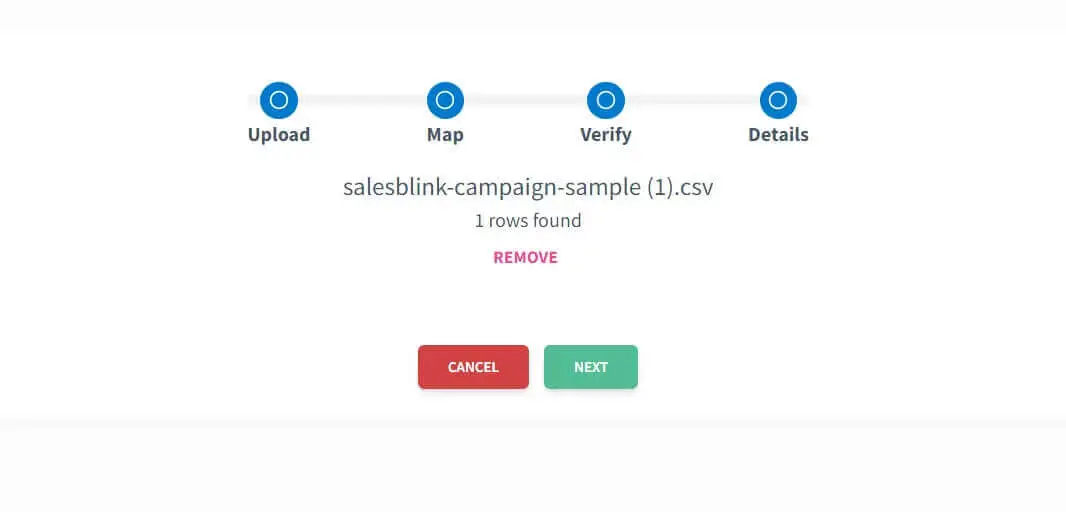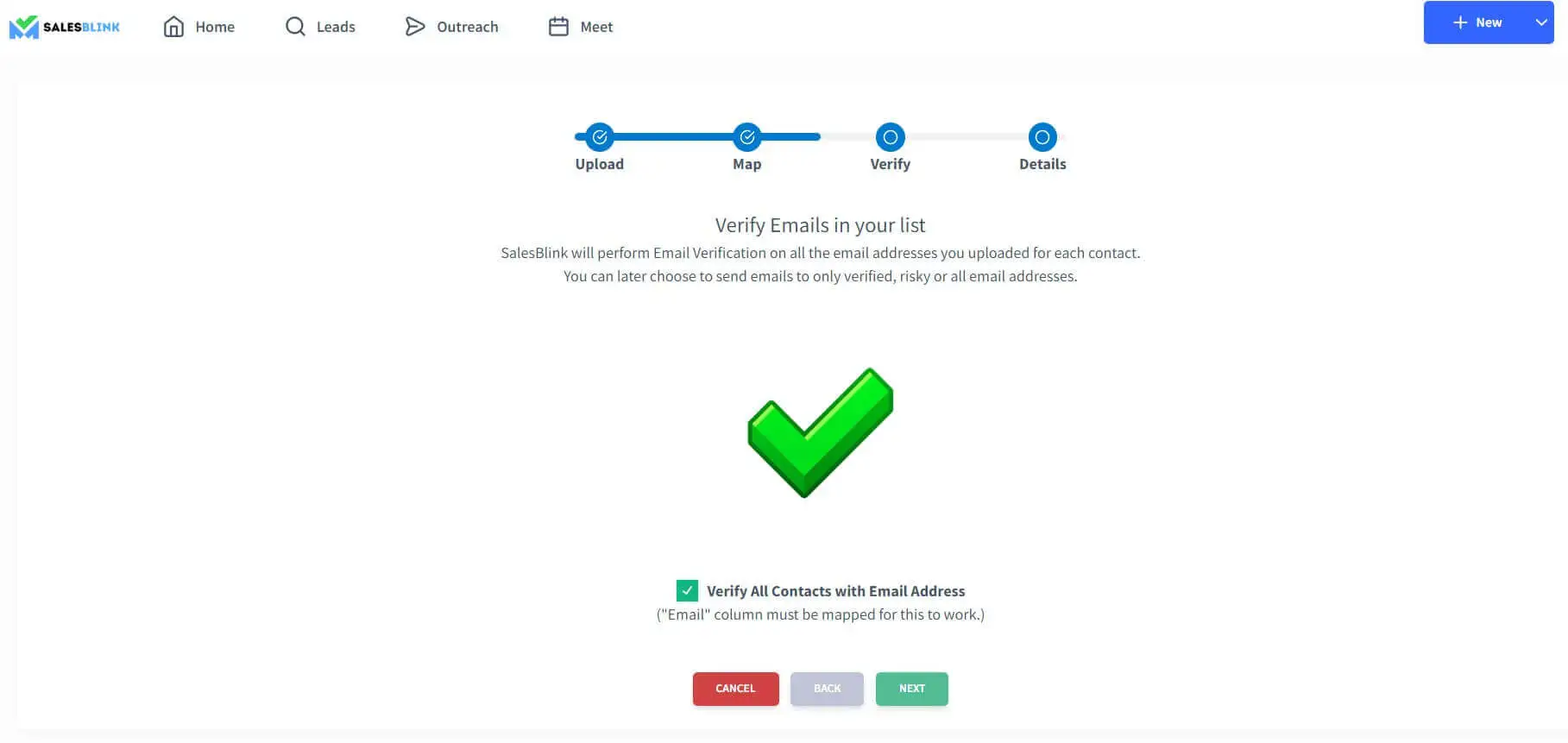How To Verify Email Addresses For Cold Emails?
Have you ever wondered what happens when you send emails in bulk to invalid or non-existent email addresses? It will lead to bounces that can affect your sender reputation and email deliverability to a great extent. Moreover, mailing spam traps repeatedly can increase the chances of getting marked as spam. Therefore, it is important to verify email address lists for cold emails.
But how?
Well, the answer is simple enough – using email verification tools! They can reduce bounce rates and remove spammy and invalid addresses that help your mailing list stay clean.
Let’s understand the basics of email verification and how you can do it.
Table of Contents
What Is Email Verification?
Email verification refers to the process of checking the validity of an email address and finding the likelihood of it belonging to a real person. The aim is to ensure that a real person with a valid email address engages with the email sent.
Why Should You Verify Email Addresses For Cold Emails?
Before finding how to verify email lists, it is essential to know why you should not miss the verification step. So, here is a list of reasons,
1. Keeps bounces away
Bounces can be detrimental for any cold email campaign, as already mentioned above. A high bounce rate can make your ESP or email service provider block you. It is not what you want.
The benefits of a email verification is to help you filter out the invalid addresses from the list. By doing this, you will automatically bring down your bounce rate.
2. Improves sender reputation and email deliverability
The ESP decides the quality of your email based on your sender’s reputation. Each email account has a sender reputation score. When your sender reputation score is higher, your email deliverability will also be higher.
Sending emails to invalid or spammy addresses can make ESPs suspend your account. That is why you have to verify the email addresses on your list.
3. Better engagement
By removing invalid email addresses, you increase the chance that your emails will reach individuals who are potentially interested in what you have to offer. This can lead to better engagement rates, including open and click-through rates.
4. Accurate metrics
When you send emails to invalid addresses, your campaign metrics can be skewed. By ensuring that you’re only sending to valid email addresses, your metrics will be more accurate, helping you make better decisions about your campaigns.
5. Gets better results from email campaigns
Keeping your mailing list free of invalid addresses can go a long way in improving the outcome of your email campaigns. When the bad addresses are removed from your list, your deliverability will improve, i.e., you are likely to hit the intended recipient’s inbox. It would increase the open rate of the emails as well as the reply rate. As a result, you can see an increase in the performance of your campaign.
Overall, you would agree that it is a must to verify email addresses before sending an email.
Email Validation vs Email Verification
Both are two different but related processes used to ensure the quality and accuracy of email addresses. Let’s have a look at them.
Email Validation
This process helps confirm that the email address is formatted correctly and meets the standards and conventions of an email address. It checks if the email address has the correct syntax, such as the presence of ‘@’ and ‘.’ symbols in the correct places, no invalid characters, etc. For instance, an email address like “user@domain.com” is valid, while “user@domain” or “user@.com” are not. Email validation cannot guarantee that the email address actually exists or is active; it only checks if it is properly formatted.
Email Verification
This process goes a step further to confirm that the email address is not only properly formatted but also exists and is active. Email verification usually involves sending a test email or using SMTP protocols to verify the existence of the mailbox without sending an email. It can confirm if the email address can receive emails. This process helps to reduce bounces and improve the effectiveness of email marketing campaigns by ensuring you are sending emails to valid addresses.
In summary, email validation considers the format and syntax of an email address, whereas email verification is about confirming the existence and activity of the email address. They are crucial in maintaining a high-quality email database and improving email deliverability.
How To Verify Email Addresses?
You can verify email address lists using two approaches: by sending emails and without sending emails.
Verifying Email Addresses By Sending Emails
Here are the two ways to verify emails for cold email by sending emails,
1. Send an email and check for bounces
One of the easiest ways to verify an email address is by sending an email to it. If it bounces, you can remove the email address from the mailing list to stop you from sending an email to it in the future. However, this method of verifying emails is not appropriate. It can severely ruin your metrics and impact your domain reputation.
2. Send a test email
A simple yet quick solution to verifying emails involves sending a test email from a dummy account.
When you get a hard bounce, you can remove the email address from your mailing list. As you send the email from a different domain name, you don’t have to worry about your reputation getting affected.
This method is relatively easy but has its pitfalls as well. Using it, you have to check for the responses manually, which is both annoying and time-consuming. The results of this approach are also not entirely accurate as your messages can end up in the spam folder.
That makes us move on to other ways of verifying emails.
Verifying Email Addresses Without Sending Emails
Here are ways to verify email address without sending email,
1. Checking the syntax of the email
The most common problems with email addresses are typographical and syntactical errors. You have to check for them manually and change them.
To understand syntax errors better, you should know what an email address looks like.
A standard email address has the 3 parts: a unique identifier, @, and a domain name.
Consider this address – xyz@abc.com.
In this email address, xyz is the email’s unique identifier, and it has a limit of 64 characters. You can use English letters in uppercase and lowercase, digits from 0-9, and special characters ! # $ & % ‘ * + – / = ? ^ _ ` | {
The @abc is the domain name. It can be something like @gmail.com or @salesblink.io.
It is crucial to check whether the email follows the above syntax, or else the emails will bounce back. There are also chances of typographical errors like @gmol.com instead of @gmail.com, which makes emails bounce back.
2. Ping the server
Another way of verifying email addresses without sending emails is by pinging the server. To carry out this check, you require a dedicated tool such as PuTTY for Telnet in Windows. While pinging the server is an accurate way of verifying email addresses, it is challenging and can negatively affect your system.
3. DNS Lookup technique
Using the DNS Lookup technique, you can check the domain authenticity. You can do so easily when you use the right tool. One such tool is MXToolbox DNS Check.
Here is how to use it,
- Open MXToolbox DNS Check.
- Enter the domain name you want to check in the text box and click ‘DNS check’.
You can see the hostname and DNS record details.
In case the details of the domain do not appear, it means the domain is not available.
This technique helps you determine whether the domain exists or not but cannot guarantee you 100% deliverability.
4. IP address lookup
Another way of checking the authenticity of an email address is by performing an IP address lookup. Using this technique, you get the IP details of a recipient’s email account.
First, you have to find the IP address of the recipient. Again you can use MX Toolbox for this purpose.
- Enter the email address of the recipient in the text box and click ‘MX Lookup’.
- A list of IP addresses connected to the email address will appear. You can select any of them.
Next, use tools available on the internet for your IP address lookup. Enter the IP address in a tool of your choice and get the IP details of the recipient’s email server. You can check everything in the result of the lookup, and if there is something weird, it can be a case of email spoofing or the email address being risky.
5. Using an email verification tool
While all of the above techniques of verifying email addresses seem to work, it is always better to have a dedicated tool that would carry out all the verification for you in one place. With an automated verification tool, you only need to enter the mailing list, and the tool will do the verification for you. In fact, this is the best way to verify email addresses.
How To Use SalesBlink’s Email Verification Tool?
SalesBlink is a sales outreach automation suite. Salespeople can use it to automate cold outreach and do much more to help save time.
The platform has an in-built email verification tool that verifies your mailing list so that you can proceed with the outreach phase without a worry.
Here’s how to go about it,
- Go to ‘Leads’ > ‘Lists’ > ‘+ New List’.
2. Upload your CSV file of contacts and click on ‘Next’.

3. Map the fields with SalesBlink Property.
4. Once you map the email filed, you can verify the email addresses by checking the ‘Verify All Contacts with Email Address’.

5. You can name the list and click on next. Your list will have verified email addresses in it.
The next step is to perform outreach. Sign up for a trial today.
When Should You Verify Your Mailing List?
Now that you know that you can verify your prospects’ email addresses using SalesBlink’s email verifier, you must be wondering how frequently you should validate your mailing list. Here’s when you should do the check,
1. Upon getting a new mailing list
If you have a brand new mailing list for your email campaign, you must verify it before proceeding. There is a high chance of having invalid contacts or malicious contacts that can tarnish your sender’s reputation and thereby your email deliverability. However, once you verify the emails and have only genuine addresses on your list, you can move ahead in the sales cycle.
Our email verifier has 99% accuracy, which is good enough for reducing the email bounce rates.
2. When there is an increase in bounce rate
If you see an increase in the bounce rate of your campaign and you have been using the email list for a long time, you should get it rechecked. When there are too many bounces, your email deliverability will get affected. Therefore, it is better to verify email addresses and get rid of invalid ones from your list.
3. Periodically
Periodic checking of the cold email list is essential. You have to do so quarterly or half-yearly because the email address on your list can become invalid with time. For example, when an employee resigns his job or gets promoted his email address changes. So, the one on your list would not be active anymore.
There are many such genuine reasons due to which emails turn invalid. Thus, it is up to you to check your list from time to time and remove bad addresses.
What Should You Choose – A Free Email Verification Tool Or A Paid Tool?
You have so many free tools to verify email addresses that it is natural to get inclined towards them. However, some free tools only let you verify one email address at a time which is not suitable for busy salespeople who have so many email addresses to verify in a day. That is why it is better to go in for a paid tool that will support bulk verification. You can save a considerable amount of time with a paid tool and invest it in nurturing leads.
Start Verifying Your Emails!
Email address verification is an essential step you should follow before you start your cold email campaign. This practice will also help you immensely in email marketing. For the uninitiated, there is a difference between cold emailing and email marketing. Both are two very different strategies.
Coming back to verifying emails, the practice will prevent email bounces and keep you away from sending emails to malicious addresses. It would be best to use a reliable email verification tool that allows you to validate email addresses in bulk.
Wish you all the luck in verifying your emails!
FAQs
Checking the syntax of the email, pinging the server, DNS Lookup technique, IP address lookup, using an email verification tool are the top ways to verify email addresses without sending an email.
Some free tools let you verify one email address at a time which is not suitable, so it is better to choose a paid tool that will support bulk verification. You can save a considerable amount of time with a paid tool.
Email verification is an essential step as it prevents email bounces & prevents you from emailing malicious addresses. It would be best to use a reliable email verification tool that does bulk email verification.







